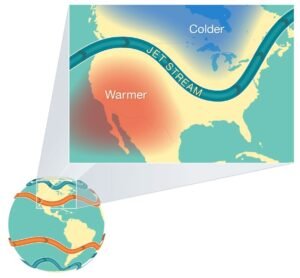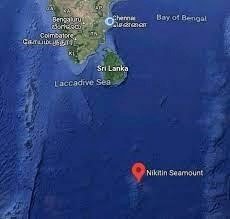GS Paper 1
1. Polar Vortex
- News: Polar vortex is ‘spinning backwards’ above Arctic after major reversal event.
- Polar Vortex:
-
- The polar vortex is a large area of low pressure and cold air surrounding both of the Earth’s poles.
- It always exists near the poles, but weakens in summer and strengthens in winter. o The polar vortex extends from the tropopause (the dividing line between the stratosphere & troposphere) through the stratosphere & into the mesosphere (above 50 km).
- Low values of ozone & cold temperatures are associated with the air inside the vortex.

- Vortex:
- The term “vortex” refers to the counter-clockwise flow of air that helps keep the colder air near the Poles.
- The Impact of Polar Vortex on Winter Weather:
- Many times during winter in the northern hemisphere, the polar vortex will expand, sending cold air southward with the jet stream.
- This occurs fairly regularly during wintertime and is often associated with large outbreaks of Arctic air in the United States.
- Portions of Europe and Asia also experience cold surges connected to the polar vortex.
- Jet Stream:
- Jet streams are narrow bands of strong winds that usually blow from west to east around the world.
- There are four main jet streams on Earth – two polar jet streams and two subtropical jet streams.

-
- Jet streams form when warm air masses meet cold air masses in the atmosphere.
- The Sun doesn’t heat the whole Earth evenly. That’s why areas near the equator are hot and areas near the poles are cold.
- So when Earth’s warmer air masses meet cooler air masses, the warmer air rises up higher in the atmosphere while cooler air sinks down to replace the warm air. This movement creates an air current, or wind.
- A jet stream is a type of air current that forms high in the atmosphere.
- On average, jet streams move at about 110 miles per hour.
- The jet stream exists in the mid to upper troposphere — the layer of Earth’s atmosphere where we live and breathe. Airplanes can fly in the jet stream.
2. Afanasy Nikitin Seamount
- News: India recently submitted applications to explore two expansive areas of the Indian Ocean seabed. The request to explore the Afanasy Nikitin Seamount (AN Seamount) presents significant benefits for India.
- Afanasy Nikitin Seamount:
- The AN Seamount is located in the Central Indian Basin, about 3,000 km from India’s coast.
- It measures approximately 400 km in length and 150 km in width.
- The seamount rises from a depth of about 4,800 meters to approximately 1,200 meters.
- It is rich in deposits of cobalt, nickel, manganese, and copper.

- Laws for Extraction:
-
- Any country or interested party seeking to extract resources from the AN Seamount must apply for an exploration license to the International Seabed Authority (ISA).
- These rights are specific to areas that are part of the open ocean, meaning ocean — whose air, surface and sea-bed — where no countries can claim sovereignty.
- Around 60% of the world’s seas are open ocean and though believed to be rich in a variety of mineral wealth, the costs and challenges of extraction are prohibitive. o Currently no country has commercially extracted resources from open oceans. o Countries have exclusive rights up to 200 nautical miles, and its underlying sea-bed from their borders.
- The UNCLOS-linked body, the Commission on the Limits of the Continental Shelf, decides on the limits of a country’s continental shelf.
-
- International Seabed Authority (ISA):
-
-
- The ISA is an autonomous international organization established under the United Nations Convention on the Law of the Sea (UNCLOS).
- It was established under the 1982 United Nations Convention on the Law of the Sea (UNCLOS) and the 1994 Agreement relating to the Implementation of Part XI of the United Nations Convention on the Law of the Sea (1994 Agreement).
- Aim: ISA is the organization through which States Parties to UNCLOS organize and control all mineral-resources-related activities in the Area for the benefit of humankind as a whole.
- Members: All States Parties to UNCLOS are members of ISA. Presently, ISA has 169 Members, including 168 Member States and the European Union. o Headquater: ISA headquarters is in Kingston, Jamaica.
-
GS Paper 2
3. Investment Facilitation for Development (IFD) Agreement
- News: India should reconsider its defensive approach towards plurilateral agreements such as the Investment Facilitation for Development (IFD) Agreement.
- IFD:
- It is a most-favoured-nation-based, plurilateral agreement.
- Negotiations for an IFD agreement at the WTO were launched in 2017 on a plurilateral basis by 70 countries through a process known as the Joint Statement Initiative.
- The IFD agreement was finalised in November 2023.
- Presently, around 120 of 166 WTO member countries (more than 70% of the membership) back the IFD agreement.
- This initiative aims to develop a global agreement on IFD to improve the investment and business climate and make it easier for investors in all sectors of the economy to invest, conduct their day-to-day business and expand their operations.
- Membership:
- Currently, the IFD Initiative has participation from over 120 WTO members.
- It is open for all WTO members to join.
- Legality:
- Plurilateral agreements under the WTO are binding only on those members that have accepted them.
- 13th WTO Ministerial Conference (MC13):
- At the 13th WTO Ministerial Conference in Abu Dhabi, the members involved in the Investment Facilitation for Development (IFD) Initiative held a Ministerial event to announce the completion of the IFD Agreement and make it public.
- They requested its incorporation into the WTO as a plurilateral agreement, open for all WTO Members to join under Annex 4 of the Marrakesh Agreement establishing the World Trade Organization.
- However, many countries including India opposed the adoption of IFD at the 13th WTO Ministerial Conference .
- It must be noted that according to WTO rules, any of its 164 members can block a deal from being adopted by the body.
- Why is India Opposing IFD:
- IFD has attracted criticism for potentially favouring countries heavily reliant on Chinese investments and those with sovereign wealth funds.
- According to India, IFD is a China-led group that wants to bring the proposal through Annexure-4 of the WTO, under which the proposal would be binding for signatory members and not for those who oppose it.
- India also pointed out that the IFD does not fulfil the criteria for a formal agreement as it hasn’t received unanimous support from all WTO members, thus lacking the exclusive consensus required.
GS Paper 3
4. Food Waste Index Report
- News: The UNEP Food Waste Index Report 2024 has been released.
- Food Waste Index Report 2024:
- The report is a collaborative effort between the United Nations Environment Programme (UNEP) and WRAP (Waste and Resources Action Programme), a non-profit organization based in the UK.
- It monitors both global and national levels of food waste, including waste generated at retail and consumer levels, encompassing households and food service establishments.
- It provides guidance for countries on improving data collection and suggests best practices in moving from measuring to reducing food waste.
- The primary objective is to stimulate necessary actions aimed at reducing food waste and achieving Sustainable Development Goal (SDG) 12.3 set by the United Nations.
- SDG 12 aims to promote sustainable consumption and production patterns.
- Target 12.3 specifically aims to halve per capita global food waste at the retail and consumer levels and decrease food losses throughout production and supply chains, including post-harvest losses, by the year 2030.
- The report defines ‘food waste’ as food and its associated inedible parts that are removed from the human food supply chain.
- Findings of Report:
- More than one billion tonnes of food – almost one-fifth of all the produce available on the market – was wasted in 2022, most of it by households.
- Only four G20 countries (Australia, Japan, UK, the USA) and the European Union have food waste estimates suitable for tracking progress to 2030.
- According to recent data, food loss and waste generates 8-10 per cent of annual global greenhouse gas (GHG) emissions – almost 5 times that of the aviation sector.
- Food loss leads to significant biodiversity loss by taking up the equivalent of almost a third of the world’s agricultural land.
- The toll of both food loss and waste on the global economy is estimated at roughly USD 1 trillion.
- Food waste is not just a ‘rich country’ problem, with levels of household food waste differing in observed average levels for high-income, upper-middle, and lower-middle-income countries by just 7 kg per capita.
- Hotter countries appear to generate more food waste per capita in households, potentially due to higher consumption of fresh foods with substantial inedible parts and a lack of robust cold chains.
5. Solar and Heliospheric Observatory (SOHO)
- News: NASA’s SOHO mission celebrates milestone as it captures 5,000th comet on its journey around the Sun.
- SOHO:
- The Solar and Heliospheric Observatory (SOHO) is a joint project of the European Space Agency (ESA) and NASA.
- It was launched in 1995. o It is designed to study the Sun, its atmosphere, and the solar wind.
- It has provided knowledge into the structure of the Sun, including its magnetic field, solar flares, coronal mass ejections (CMEs), and solar variability.
- Key Findings:
- The SOHO mission has achieved a milestone in its journey by capturing its 5,000th comet as it traverses around the solar star in the cosmic neighbourhood.
- In order to provide continuous observations, it was maneuvered to orbit the first Lagrangian point (L1), a point some 1.5 million km (900,000 miles) from Earth toward the Sun where the gravitational attraction of Earth and the Sun, combine in such a way that a small body remains approximately at rest relative to both.
- It carries 12 scientific instruments to study the solar atmosphere, helioseismology, and the solar wind. o Information from the mission has allowed scientists to learn more about the Sun’s internal structure and dynamics, the chromosphere, the corona, and solar particles.
- Though its mission was scheduled to run until only 1998, it has continued collecting data, adding to scientists’ understanding of our closest star, and making many new discoveries, including thousands of comets.
- SOHO is the longest-lived Sun-watching satellite to date.
6. Mushk Budiji
- News: J & K authorities plan revival of Mushk Budiji, a new rice variety.
- Mushk Budiji: The Kashmir Himalaya is known for the cultivation of mushk budiji, an indigenous rice variety distinguished for its rich aroma and unique taste.
| 1. Joha rice, Boka Chaul rice & Chokuwa rice | Assam |
| 2. Ambemohar rice & Ajara Ghansal | Maharashtra |
| 3. Katarni rice | Bihar |
| 4. Navara rice, Kaipad, Pokkali rice, Gandhakasala, Wayanad Jeerakasala & Palakkadan | Kerala |
| 5. Chak-Hao rice | Manipur |
| 6. Kala Namak Rice | Uttar Pradesh |
| 7. Gobindobhog rice & Tulaipanji rice | West Bengal |
| 8. Basmati Rice | Punjab, Haryana, HP, Delhi,
Uttarakhand, UP, J&K |
